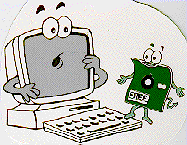
With personal computers now on seemingly every desktop, sheer competition for real estate has driven many single-purpose video terminals into retirement, replaced by a terminal-emulator program running on the usurping PC, Macintosh, or Unix workstation. (But not all.)
However, sometimes the emulation does not perform exactly the way the terminal did. One frustrated Usenet correspondent wrote:
...my experience with "VT100" emulators suggests that many, maybe even most, lack some fundamental capability [such as] the ability to respond to an auto-identification query, the ability to perform certain screen or cursor operations, the ability to transmit appropriate "editing keypad" escape sequences, etc. Beware.And he doesn't even mention the fact that the keyboard layout is almost always different.
A fellow where I used to work went through a great deal of trouble with a well known, commercially sold emulator product. However, it turned out that the product was actually tested by the vendor only against Unix applications that use "curses", so only the subset of features that "curses" employs could be depended upon to work. He eventually threw the product out.
Therefore, when you are buying a commercial terminal-emulation product, you may want to obtain some type of trial version, so that you can see if it works well enough in your particular environment.
Or if you are writing a new emulation, don't test it just with "vi". Even GNU Emacs would give your emulation a better workout! But better still (for DEC emulations) is vttest. (Or you could save yourself trouble and buy an emulator toolkit from Distinct Corporation.)
In today's networked world, TCP/IP communication is increasingly important. If you find Microsoft's TCP/IP implementation in Windows 95 to be too feature-poor, you may benefit from one of the third-party protocol stacks described in a review of six Internet Protocol packages from Information Week. (Also, the Kermit team at Columbia University used vttest to compare several Windows-95 telnet clients, including Microsoft's.)
There surely exist other vendors that I don't know about. Also, most vendors of network protocol implementations include at least some level of terminal emulation.Some vendors of terminal-emulation software for PCs and Macintoshes have been claiming to support 3270 terminal emulation--when what the product actually supports is mere emulation of a Televideo terminal with a special keymap that a protocol converter has to interpret. (The protocol converter also gets to do the tricky work of the ASCII -to-EBCDIC code translation and asynchronous/bisynchronous communication bridging.) In some environments, this setup is what you want, but sometimes you want these functions handled within the PC--as other products do. Just be certain of what you are getting!
This material now has its own Web page.
Note: Here I try to put a representative sample of terminal emulations and information available freely or as Shareware from Internet sources. These are of varying quality, but perhaps you will find some of them useful.
Here is why many shareware products contain "nag screens."
Note: The software repository at Oakland University seems to get completely reorganized about every three weeks. If some of the links below don't work, don't be too surprised. ...RSS
Some people have called EWAN "the best Winsock telnet client." Well, I've tried it, and it does have a few nice features, such as support for the telnet/rlogin "resize" commands. However, it does not properly emulate a VT100 in some cursor-addressing modes, making life very frustrating for GNU Emacs users.I've lately begun using SimpTerm, which has a different set of features but is much more usable with GNU Emacs. SimpTerm also works well with a Windows 3.1 utility that swaps the Control and the CapsLock keys. There is yet something about the scrolling that doesn't work with VMS TPU....
All the RFC-65X-series Telnet-option specifications have now been reclassified by the Internet Architecture Board as "historic" protocols.
Another bit of Telnet-protocol history is described as part of the story of the Multics implementation of the EMACS Editor.
What Microsoft calls a "terminal server" is not what the rest of the industry calls a terminal server. However, since resistance is futile and we are all now absorbed, here are links for clients packages that can connect only to Windows NT via the Microsoft proprietary protocols. Be forewarned that these products are subject to frequent changes in both name and functionality, as the small vendors jockey for market position amidst Microsoft's FUD.